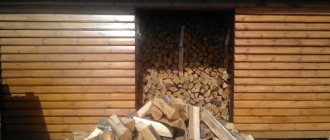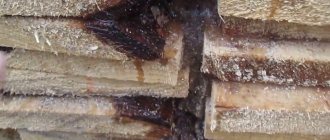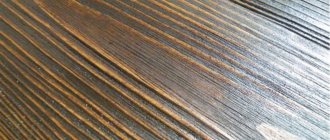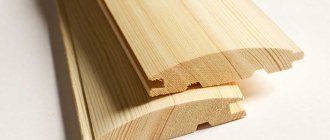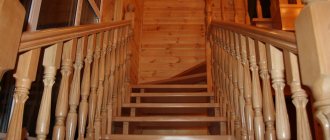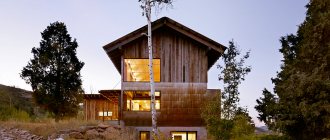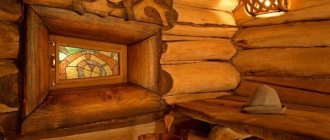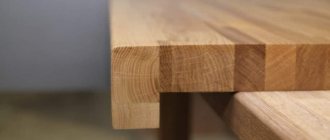At the moment, covering the surface with clapboard is one of the most popular options for finishing the surface. Unfortunately, after a certain period of time, the shalevka loses its former attractiveness and begins to darken. What to do if the lining has darkened? Is it possible to correct the current situation or will I have to do all the work again?
Painting the lining
Why bleach wood
Among the fungi that attack wood, there are both very dangerous ones that destroy it, and quite harmless ones that cannot affect the structure of the tree. But they spoil its appearance, causing the appearance of black, green, blue or brown spots. During their life activity, wood-staining fungi increase the permeability of wood to moisture, and in a humid environment, harmful wood-destroying microorganisms can already develop. Therefore, it is necessary to combat this phenomenon not only to restore the marketable appearance of lumber, but also to protect it from more dangerous fungi.
Blackness and blueness can appear not only on fresh boards and logs, it also affects finished wooden structures, especially those that are not protected or are used in damp conditions. Not only does bleached wood look better, it is more resistant to infestation by dangerous mold organisms.
Logs damaged by blue fungus Source winterhouse.ru
The cause of wood discoloration is not always caused by fungi. It gradually darkens and turns gray from contact with air, under the influence of sunlight. Unsightly dark spots often appear around the installation sites of metal fasteners and fittings. This happens as a result of a chemical reaction between iron particles and phenols contained in wood.
In such cases, bleaching the wood with bleach or special means also helps restore the original color of the surface.
Finally, bleaching is used when it is necessary to lighten the natural shade of wood. The active components of the bleach discolor not only fungal cells, but also the pigment bonds of lignin - a natural polymer compound that holds the cells and fibers of wood together and determines its color.
Old grayed boards before and after bleaching Source kraski-net.ru
Second lightening method
There is also another way to tidy up the lining and improve its darkened structure.
To do this, the darkened wood should be cleaned of the old coating and the surface should be thoroughly washed with Techopesu detergent. This unique composition has a bleaching effect and instantly brightens damaged material.
Important! To remove mold and blue stains on the lining, you need to use a detergent called Homeenpoisto.
After processing the lining, it is necessary to cover it with paint and varnish material, paint or a glazing antiseptic. These methods will help the material not to lose its original appearance and not fade in the sun.
Now you know how to update darkened lining without much effort. We wish you a pleasant renovation!
Source
Types of bleaches
Products intended for bleaching wood are divided into two categories - chlorine-containing and chlorine-free. To choose what to bleach wood with, you need to know their properties and features.
Chlorine-free bleaches
This group includes compositions based on acetic and oxalic acid, hydrogen peroxide, ammonia, various salts and alkalis. Their main advantage over chlorine bleaches is their low aggressiveness towards the wood structure. Such means do not violate its structure or affect its strength. In addition, they are easier to use, since they do not have a strong odor that forces you to use protective equipment, and are easily washed off.
Note! Any bleach must be washed off or neutralized after application and exposure to the surface.
Soft bleach Holtz Source incolors.ru
See also: Catalog of companies that specialize in the reconstruction and rebuilding of houses
However, the intensity of exposure and duration of action are lower for chlorine-free bleaches, since they penetrate shallowly. Therefore, they are used in the following cases:
- when you need to treat old, gray wood that has changed color due to time, and not due to exposure to fungi;
- when work is carried out in a residential area or in a bathhouse;
- to remove rust stains around fasteners;
- to eliminate small foci of fungal infections - blue discoloration, dry mold, blackening.
One of the most popular chlorine-free bleaching products is Senezh Effo.
Chlorine bleaches
This group includes products based on chlorine dioxide, sodium hypochlorite, and bleach. They solve the problem of how to bleach wood infected with staining or mold fungus, destroying its spores and discoloring the cells. That is, chlorine compounds also serve as an antiseptic.
Chlorine bleach is used to restore large area lesions Source landshaftnik.com
They penetrate deep into the structure of the wood and act more effectively, but at the same time they are washed off less easily, leaving alkali salts that destroy the fibers and make the wood loose and more vulnerable to wood-destroying fungi. Therefore, after treatment with bleach, it is necessary to apply a protective paint layer, wax or other composition that creates a water-repellent film to the surface.
Other disadvantages of these products are associated with their aggressive composition and pungent odor. You can work with them only in protective equipment, strictly following all the manufacturer’s instructions and without mixing with other drugs. For the same reason, they should not be used for bleaching wood in residential premises or should be done with great caution.
The most effective and popular products in this category:
- Neomid 500;
- Prosept 50;
- Sagus;
- Ecosept 500.
Chlorine bleach Ecosept Source ukr.bio
Why does the lining darken?
As practice shows, darkening of the surface of the lining is a fairly common phenomenon. In most cases, the reason for this is the negative influence of external factors. Among other things, darkening may be due to improper storage of the material or its poor quality.
Another important nuance that should be taken into account is that any wood, regardless of how it was treated, loses its attractiveness over time and begins to darken. For example, if you pay attention to the cedar shalevka, it is very afraid of sudden temperature changes, as well as exposure to moisture.
Darkening
As for linden, it is less capricious, but, one way or another, it also gradually begins to change its color to a darker one. A similar situation is observed with regard to pine or larch lining, as the photos clearly indicate.
Can I use home remedies?
Products such as bleach, acetic acid and hydrogen peroxide are found in every home, so the temptation to use them instead of special expensive compounds is very great. But you shouldn’t do this, even though they work well. Not only can they leave streaks or change the color of the wood unpredictably, but they also act at a slower speed and require repeated application. And a long period of exposure without rinsing is fraught with the risk that the alkaline salts will penetrate too deeply, will not be washed out and will remain inside, having a destructive effect on the wood.
Video description
You can see how a special bleach and whiteness for wood works in this video:
As you can see, the effectiveness of professional products is noticeably higher, since in addition to the main active compounds they contain additives to improve bleaching and other properties.
- Catalysts promote better penetration of bleaching substances deep into the wood.
- Stabilizers prolong their effect time.
- Surfactants make rinsing easier.
- Fungicides disinfect and antiseptic wood, destroying pathogenic flora.
In addition, bleaches are usually available in concentrated form; they are diluted with water in a certain proportion, which is selected depending on the degree of damage. Therefore, their consumption is relatively small, and instructions for use are detailed on the packaging.
It is more difficult to use home remedies precisely because it is impossible to determine the required concentration of the active substance. For example, bleaching wood with hydrogen peroxide is ineffective; instead, it is better to use a more concentrated perhydrol, and after exposure, be sure to neutralize it with a 4% solution of acetic acid. This means extra time and extra labor.
Regular 3% peroxide will not cope with bleaching; it is better to take a concentrated solution for swimming pools Source oknakr.dp.ua
For reference! All professional bleaches are washed off with plain water, with the exception of acidic ones. To neutralize them, soda is added to the water.
How and when to whiten
Wood staining and mold fungi develop very quickly under favorable conditions. Blackness and blueness spread not only over the surface, but also go deeper. Therefore, the earlier the treatment is carried out, the greater the effect it will have and the less it will harm the wood.
If bleaching is done indoors, people and animals must be removed from the area before the job is completed. It is advisable to open windows or turn on ventilation. Particular attention to how to bleach wood in a bathhouse. Firstly, this should be done immediately after the first signs of damage are detected, before small lesions spread over the entire surface. In conditions of high humidity and temperature this happens very quickly. Secondly, it is better to use special products for baths and saunas.
Detergent with bleach for baths and saunas from Tikkurila Source tikkurila-shops.ru
Any wood bleaching products work best at temperatures of 10-30 degrees and normal air humidity. In such conditions, they are quickly absorbed and actively affect fungi. Some can be used at lower and even negative temperatures, which must be indicated in the instructions.
But during the cold season, there is no urgent need to destroy the fungus, since it remains inactive and does not multiply until the onset of warm weather.
It is important! Some reagents in bleaches can affect the natural color of wood, changing its shade. If this is not desirable, then it is better to first experiment on scraps of boards of the same type or in inconspicuous places.
If wooden structures are to be planed or sanded, then this is done before bleaching the wood, since bleaches penetrate to a shallow depth, and after removing the top layer of wood, dark spots may again appear on it.
Classification of painting materials
Darkened lining can be painted with oil, alkyd or acrylic paints to restore the attractiveness of the surface. Let's look at the advantages and disadvantages of each type of paint.
Oil paints
They have an unpleasant odor and are painted in good weather so that the room can be ventilated.
Positive sides:
- service life is approximately 5 years;
- the paint is well absorbed by wood and dries within 24 hours;
- oil coating protects against moisture;
- The low cost is captivating.
The disadvantage is the loss of shine during long-term use, it is difficult to apply another type of coating on top of this coating, and the oily surface does not breathe.
Alkyd paints
They are used for walls and floors. However, they should be applied to a completely dry surface, otherwise bubbles will form and the paint composition will then peel off. The alkyd composition is resistant to moisture and its cost is low.
Acrylic based paints
Experts recommend using these paints for lining because of their many advantages.
- Acrylic paints are environmentally friendly and do not harm human health. They breathe, protect from moisture and are resistant to sub-zero temperatures.
- Acrylic is odorless, dries quickly, without forming streaks.
- The surface remains attractive for a long time.
- However, you should not buy cheap types of acrylic paints - they can change color after drying. And also the process of applying acrylic is lengthy; it is necessary to apply the next layer after the previous one has completely dried.
Read about construction paints and new products on the market.
Advice from experienced craftsmen
- If you paint with oil paints, then the shade is chosen one tone darker than the desired color, since over time the surface becomes lighter.
- Do not paint in hot weather; drying occurs quickly and the surface may crack.
- The lining should be coated with polyurethane varnish, which will enhance the texture effect and naturalness of the wood.
- The color of natural wood is more suitable for bedrooms and country rooms.
So we looked at the issue, the lining has darkened, what to do . To enjoy attractive lining longer, you need to know about the basic rules for using wood and follow them. To choose lightening, consult with specialists.
If you find an error, please select a piece of text and press Ctrl+Enter.
Share with your friends on social networks!
Briefly about the main thing
Products that bleach wood surfaces are divided into chlorine and non-chlorine. The former cope better with fungi, the latter are more often used to restore the color of old wood. But they do not protect it from discoloration in the future. The wood may darken again from ultraviolet rays or wood-staining bacteria. To prevent this from happening, darkened structures need to be treated as early as possible, before the fungus goes deeper, then antiseptically carry out and a protective coating is applied.
Ratings 0
Surface care tips
Lining is a proven, reliable material, but it needs to be properly looked after and protected from adverse influences. Let's look at the basic rules:
- Periodically treated with fire retardants and antiseptics to combat mold and fire.
- Even after sanding, the texture retains a slight roughness, so dust can accumulate. It is removed during cleaning. This is done with a vacuum cleaner using a soft attachment. Alternatively, use a dry or slightly moistened cloth. A vacuum cleaner in washing mode and a rag that is too wet are prohibited.
- The use of soda, powdered cleaners and other abrasives is not allowed. You should not try to clean the resulting stains with solvents and other aggressive compounds; you should purchase a specialized product, for example: “Tytan”, “Wood Clean”, “Grass TORUS”.
- The main thing that will help preserve the ceiling lining and make it easier to maintain is the paint coating, taking into account the conditions in which it will be used. For problem areas, latex paints and polyurethane enamels are selected that can withstand high temperatures and create an increased level of moisture protection.
If you use paint and varnish products in accordance with their intended purpose and carry out protective treatment in a timely manner, then the wooden ceiling will serve for a long time not only indoors, but also on verandas, balconies, unheated cottages, in bathrooms and bathhouses.

